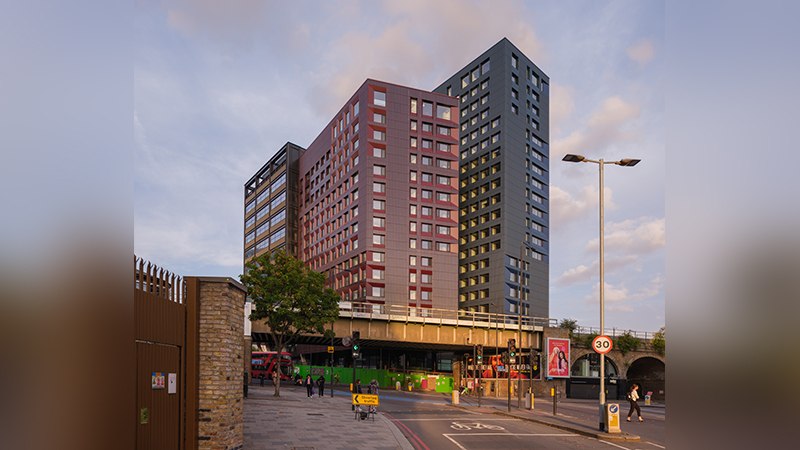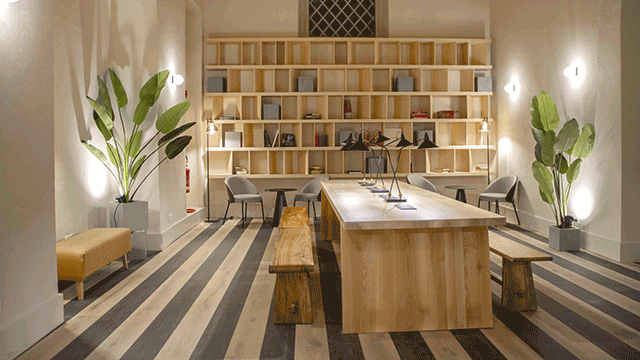Rent Act 1977, section 12 — Whether tenancy protected or excluded from protection because of the resident landlord exception — Issue as to whether the building of which the dwelling-house formed part was a ‘purpose-built block of flats’ — In order to qualify for the resident landlord exception the building must not be within such a description — In all other respects the conditions of section 12 were satisfied — By Schedule 2, para 4, to the Act of 1977 a building is a purpose-built block of flats ‘if as constructed it contained, and it contains, two or more flats’ — Building in present case was originally a large Victorian house which was subsequently converted into a number of flats — It was argued on behalf of the tenant that ‘as constructed’ should be construed to mean as constructed in its present form, ie as divided into flats, not as originally designed and
This was an
appeal by the tenant, Mrs Rita Mary Barnes, from a decision of Judge Clarke at
Torquay County Court refusing her a declaration that her tenancy of Flat 5,
Denby House, Belle Vue Road, Paignton, Devon, was a protected tenancy. The
landlords, respondents to the present appeal, were Peter John Gorsuch and
Heather Gorsuch.
John Colyer QC
and S Bickford-Smith (instructed by Gowan Easterbrook & Co, of Paignton)
appeared on behalf of the appellant; John A Hodgson (instructed by Boyce,
Hatton & Co, of Torquay) represented the respondents.
Giving the first
judgment at the invitation of Sir John Arnold P O’CONNOR LJ said: This is an
appeal from an order of His Honour Judge Clarke made in the Torquay County
Court, whereby he refused to make a declaration in favour of the plaintiff that
her tenancy of Flat 5, Denby House, Belle Vue Road, Paignton, was a protected
tenancy.
The defendant
landlord relied on the provisions of section 12 of the Rent Act 1977. So far as
material that section provides:
12(1) Subject
to subsection (2) below, a tenancy of a dwelling-house granted on or after 14th
August 1974 shall not be a protected tenancy at any time if — (a) the
dwelling-house forms part only of a building and . . . the building is not a
purpose-built block of flats;
All the other
requirements of the section were fulfilled.
Flat 5 is a
dwelling-house; it forms part only of a building, and the learned county court
judge has held that that building is not a purpose-built block of flats. The
plaintiff contends that the learned judge ought to have found that it was a purpose-built
block of flats and thus taken the tenancy out of the exemption. That is the
sole issue in this appeal.
A
purpose-built block of flats is defined by paragraph 4 of Schedule 2 to the
Act. That paragraph reads:
4. For the
purposes of section 12, a building is a purpose-built block of flats if as
constructed it contained, and it contains, two or more flats; and for this
purpose ‘flat’ means a dwelling-house which —
(a) forms part only of a building; and
(b) is separated horizontally from another dwelling-house
which forms part of the same building.
It is that
definition section which falls for consideration in this appeal.
The underlying
facts are simply stated. Denby House is a large Victorian house in Paignton
which, from 1959 onwards, has been converted into a number of flats. It is
illustrated in agreed photographs and there are plans which I need not refer to
in detail.
In 1959 it was
first of all divided into three flats. Later on one of those was itself
subdivided into two flats and another one subdivided into three, so that one
had six flats in the old house. Finally, outside the original house, perhaps on
the site of what had been a garage, a further building was put up consisting of
two floors and that itself is divided into two flats. Flat 5 is in the main
part of the old house. So, too, is Flat 1 where the landlord resides.
The question
as to whether this conversion is a purpose-built block of flats therefore
depends on the meaning of the definition section. Undoubtedly it is a building.
What building?
Mr Colyer, on
behalf of the plaintiff, submits that in construing this paragraph one should
look at the building as it is now and so construe the words ‘as constructed’ as
to discover when it was constructed in its present form. He says if that
construction of the paragraph is adopted the answer will come back that it was
constructed in its present form in 1962 or thereabouts (perhaps in 1959) and
that at that time, if that is the right base date, then it was a purpose-built
block of flats because the other requirements are fulfilled. There are more
than two flats, horizontally divided, or two dwelling-houses. He submits that
that is a matter of law and that the court should so declare it because the
division of old houses into a number of flats is very common throughout the
country and so far there has been no decision on the point.
For my part I
cannot accept that that is a proper construction of the section. It will be
seen that the words are ‘as constructed it contained, and it contains, two or
more flats’. The latter present tense of ‘it contains’ points to its present
condition, and ‘as constructed it contained’ points to a past period. The
natural and ordinary meaning of it is, in my judgment, the building as it was
originally designed and built. If that be the correct construction, as I
believe it to be, then the learned judge’s judgment cannot be faulted.
Secondly, Mr
Colyer submitted that, even if as a matter of law conversion from a house into
two or more flats did not start the construction anew, which is how he put it,
then, on the facts of the present case, over a period of time the identity of
the building had so changed that it could no longer be looked upon as the
building put up in the latter part of the 19th century.
The learned
judge accepted that that was a consideration which he had to take into account
because he said that, in certain circumstances, an old Victorian building which
had been completely gutted out and rebuilt inside might well be a new and
different building. He had that matter clearly in mind.
In my judgment
that was eminently a matter of fact for the learned judge and there are no
grounds for saying that he came to a wrong finding when he concluded that this
building and what had been done to it had not sufficiently changed its
character to become a different building at any stage.
Thirdly, Mr
Colyer submitted that the learned judge did not sufficiently have in mind the
purpose of section 12. The purpose of that section was identified by Scarman LJ
(as he then was) in Bardrick v Haycock and others (1976)
31 P&CR 420. The relevant passage from Scarman LJ’s judgment is found at p
424. In that case the question was as to whether the dwelling-house occupied by
the landlord formed part of the building of which the tenants each had a flat.
The county court judge found that it did not form part of the building and it
was that finding which was before the court.
As a matter of
interest, this proposition was never argued at all. Everybody accepted that the
six flats were part of a building and that it was not a purpose-built block of
flats.
Scarman LJ
said:
I have no
doubt that the intention of Parliament in enacting section 5A was to relieve
landlords where it was reasonable to do so. One must remember that the Act of
1974 introduced furnished tenancies into Rent Act control. This meant that
resident landlords, who had under the earlier legislation counted on being able
to require furnished tenants in the same building as that in which they lived
to leave, could no longer do so. Therefore, the mischief at which the section
was aimed was the mischief of that sort of social embarrassment arising out of
close proximity–close proximity which the landlord had accepted in the belief
that he could bring it to an end at any time allowed by the contract of
tenancy.
I find some
support for this approach in the fact that the section excludes from exemption
a purpose-built block of flats. I ask myself why, and the reason must be that a
purpose-built block of flats is so designed that people can live separate lives
without embarrassment even though physically they are in close proximity to
each other. I think that such considerations must help the judge in his
approach to the question of fact in the instant case, that is, are these dwelling-houses
part of the same building or not?
That case was
cited to the learned judge and he referred to it in his judgment. It seems to
me that he had those considerations in mind. Looking at the photographs and
plans I am not surprised that the learned judge came to the conclusion that
Flat 5 and Flat 1 were dwelling-houses in the same building which was not a
purpose-built block of flats within that definition.
I can find no
error in the approach which the learned judge made in this case and I do not
think it right to attempt to lay down any question of law for the guidance of
county court judges dealing with this section. It is, as Scarman LJ pointed out
in Bardrick’s case, very simple language. The section is in simple
language and so is the definition of a purpose-built block of flats.
In the course
of argument all sorts of different hypothetical situations have been considered
by counsel and by the court, but it does not seem to me that any help is to be
derived in construing the relevant statutory words from such considerations.
They are simple
judge. The present question is just as much a question of fact as was the
question in Bardrick’s case, namely, does the landlord’s dwelling-house
form part of the same building?
In the present
case it is a question of looking at the building, having the considerations in
mind, looking at its history and asking oneself the question whether it is a
purpose-built block of flats as defined. The learned judge found that it was
not and I think he was right. I would dismiss the appeal.
STEPHEN BROWN
J: I agree.
Agreeing that
the appeal should be dismissed and with the judgment of O’Connor LJ, SIR JOHN
ARNOLD P said: When one looks at what Scarman LJ said in Bardrick v Haycock
one finds that the reason why he thought that Parliament had included the
exemption limited to other than a purpose-built block of flats was because a
purpose-built block of flats is so designed that people can live separate lives
without embarrassment. It is pointed out, and pointed out with justice, that
that is not so with every single purpose-built block of flats, nor is the
contrary so with every single conversion; but if the probability is, as Scarman
LJ suggested, that a purpose-built block of flats is likely to be the sort of
place where people can live separate lives without embarrassment, that is a
perfectly sufficient reason why the enactment was framed as it was and in
particular a circumstance which is wholly in line with the interpretation which
my Lord has put upon Schedule 2 and with which I wholeheartedly concur.
Accordingly the appeal is dismissed.
The appeal was dismissed. Legal aid taxation of costs
was ordered.










